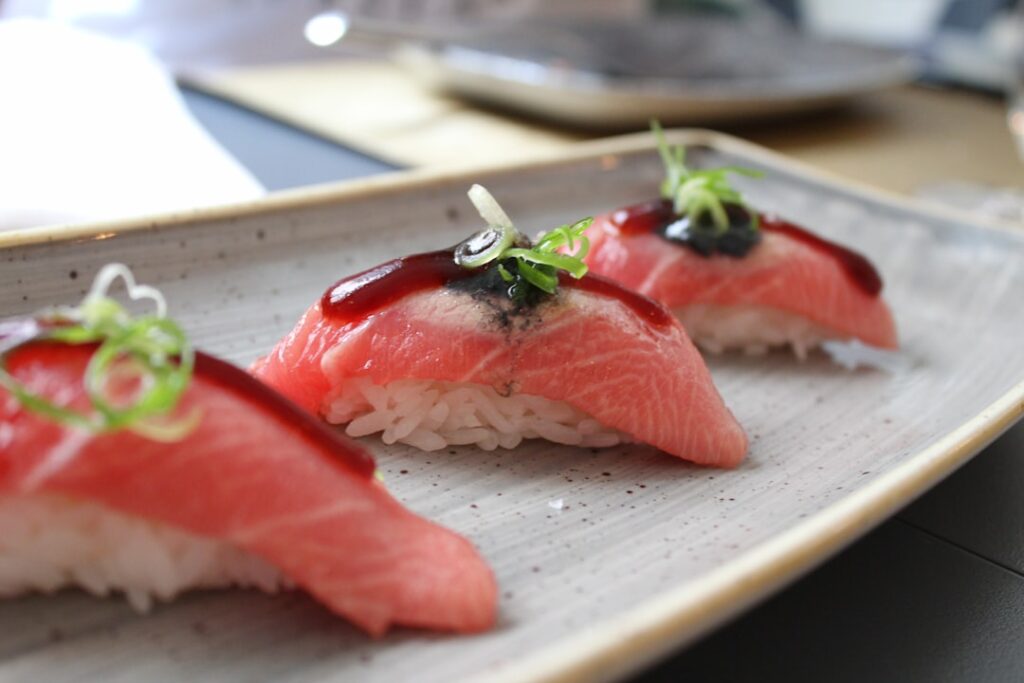Why Nigiri Represents Sushi’s Purest Art Form
Nigiri is hand-pressed sushi rice topped with a slice of fresh fish or seafood, representing the most authentic and original style of sushi that originated in 1820s Tokyo. This minimalist yet masterful creation consists of just three elements: seasoned rice, premium fish, and a touch of wasabi.
Quick Nigiri Facts:
- Definition: Hand-shaped rice mound topped with fish (usually raw)
- Origin: Invented by Hanaya Yohei in Edo (Tokyo) around 1824
- Meaning: “Nigiri” means “two fingers” in Japanese
- Serving: Traditionally served in pairs at room temperature
- Eating: Best eaten with fingers, fish-side down in soy sauce
For food-loving travelers seeking authentic culinary experiences, nigiri offers a perfect window into Japanese craftsmanship and flavor philosophy. Unlike elaborate sushi rolls popular in Western restaurants, nigiri strips away complexity to showcase the pure relationship between perfectly seasoned rice and pristine fish.
This deceptively simple dish transformed from Edo-period street food into a global culinary icon. Each piece represents hours of training – from rice preparation to fish selection to the precise hand-pressing technique that gives nigiri its name.
Whether you’re planning a sushi trip in New York City or want to master the art at home, understanding nigiri opens doors to deeper appreciation of Japanese food culture.
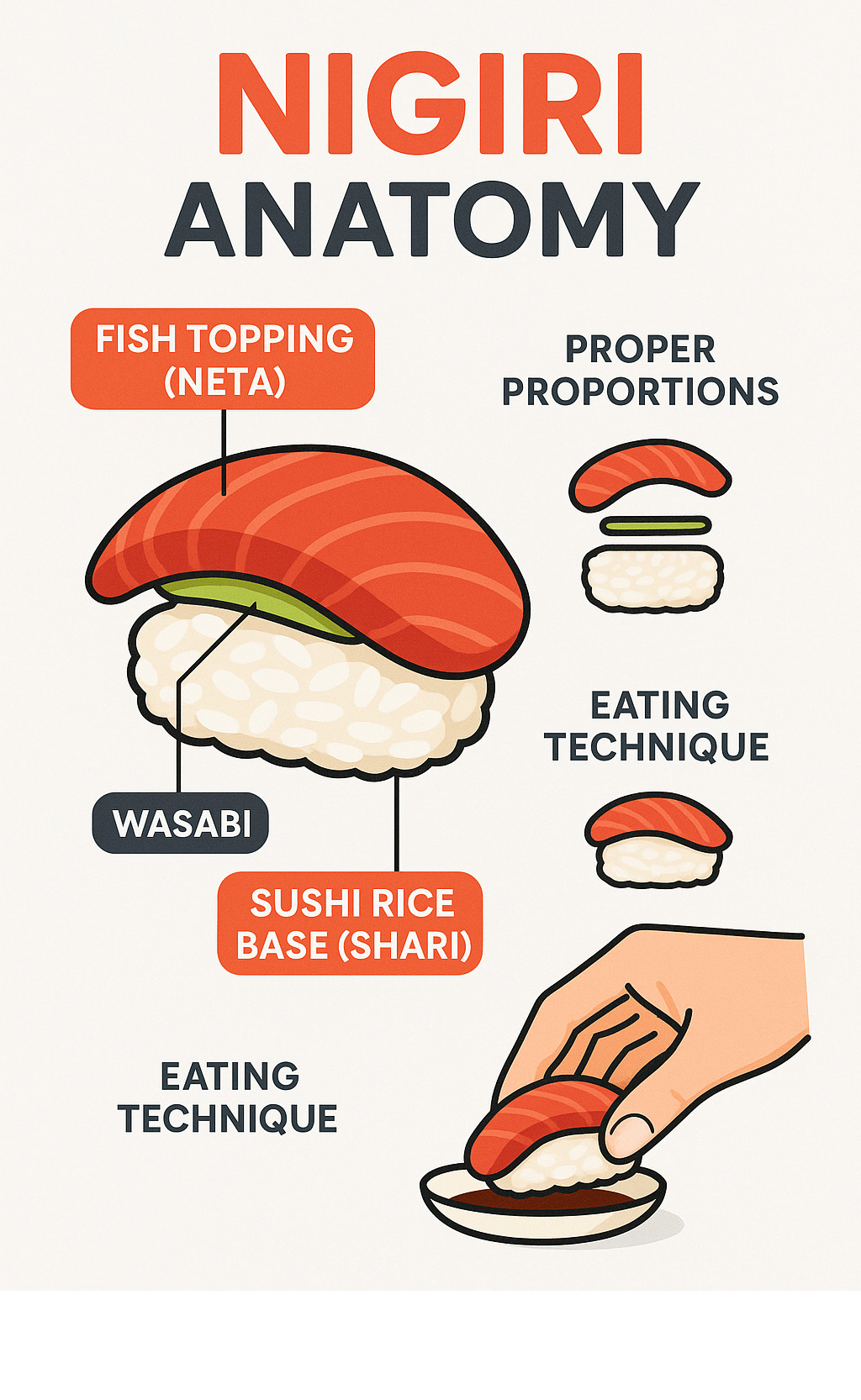
What Is Nigiri? Origins, Meaning & Pronunciation
Picture yourself in 1820s Tokyo, where the busy streets of Edo were filled with merchants and workers who needed quick, satisfying meals. This is where nigiri was born – not in an neat restaurant, but from the practical genius of a street vendor named Hanaya Yohei.
The word “nigiri” comes from the Japanese verb “nigiru,” meaning “to grasp” or “to press.” It literally translates to “two fingers” – a reference that captures both the traditional portion size and the intimate hand-forming technique that makes each piece special.
Hanaya Yohei’s breakthrough around 1824 changed everything. Traditional sushi involved a lengthy fermentation process that could take months, but Yohei had a brilliant idea: why not add vinegar directly to the rice? This innovation meant fresh fish could be served immediately on perfectly seasoned rice, creating the nigiri we know today.
Working near the Sumida River, Yohei transformed sushi from a time-consuming preservation method into genuine fast food for the merchant class. Street vendors could quickly assemble these bite-sized masterpieces, making quality sushi accessible to busy workers throughout Edo.
Pronunciation tip: Say “nee-gee-ree” with equal emphasis on each syllable and a crisp “g” sound in the middle.
Nigiri vs Sashimi: Key Differences
Here’s where many people get confused. Both nigiri and sashimi feature pristine raw fish, but they’re actually quite different dining experiences.
Sashimi is all about the fish – pure, simple, and neat. When you order sashimi, you’re getting expertly sliced raw fish or seafood served alone, without rice.
Nigiri, on the other hand, is a duet. The fish shares the spotlight with perfectly seasoned sushi rice. That rice isn’t just a platform – it’s seasoned with vinegar, sugar, and salt to create a harmony that changes as you eat.
| Aspect | Nigiri | Sashimi |
|---|---|---|
| Rice | Always includes seasoned sushi rice | No rice – fish only |
| Preparation | Hand-pressed rice topped with fish | Thinly sliced fish served alone |
| Eating Method | Fingers or chopsticks, one bite | Chopsticks, multiple bites |
| Soy Sauce | Dip fish-side only | Dip fish directly |
| Temperature | Room temperature preferred | Chilled presentation |
Nigiri vs Maki: Roll or Press?
If nigiri is like a handshake – personal, direct, and intimate – then maki is more like a carefully wrapped gift. Both are beautiful, but they represent completely different approaches to sushi making.
Maki involves wrapping rice and fillings in nori (seaweed sheets) using a bamboo mat. The chef rolls everything together, then slices the cylinder into neat rounds.
Nigiri takes the opposite approach. There’s no hiding behind nori wraps or fancy presentations. It’s just you, the rice, and the fish – which means everything has to be absolutely perfect. Each piece is individually hand-pressed, with the chef adjusting their technique based on what they’re working with.
The Evolution: From Edo Stalls to Global Icon
Hanaya Yohei probably never imagined his riverside innovation would one day circle the globe. From his humble stall, nigiri spread throughout Edo and eventually across all of Japan. The Great Kanto Earthquake of 1923 played an unexpected role – when Tokyo sushi chefs relocated to other regions, they took their nigiri techniques with them.
The post-World War II era brought changes that would make nigiri accessible to everyone. In 1958, Yoshiaki Shiraishi invented conveyor belt sushi, turning sushi dining into an interactive experience.
Nigiri’s journey to international fame began in the 1960s, introducing millions of people worldwide to the beauty of Japanese culinary craftsmanship.
Anatomy of Nigiri: Rice, Fish, and Finishing Touches
Creating perfect nigiri is like conducting a symphony with just three instruments. Each component must be precisely tuned to create that magical one-bite experience.
The foundation starts with shari – the seasoned sushi rice that forms the base of every piece. Short-grain Japanese rice gets carefully seasoned with a blend of rice vinegar, sugar, and salt, then cooled to room temperature. The texture needs to be just right – sticky enough to hold its shape when pressed, yet light enough to practically melt on your tongue.
Here’s something that might surprise you: master sushi chefs use only about 100 grains of rice per nigiri piece, while many restaurants pile on up to 400 grains. This difference separates the authentic experience from the filling one.
Neta – the fish or seafood topping – requires equally precise attention. Each slice is cut against the grain into pieces roughly 3 inches long, 1 inch wide, and 1/4 inch thick. This specific cutting technique ensures the fish has the perfect texture and drapes naturally over the rice mound.
Between the rice and fish lies a tiny amount of wasabi – real wasabi, not the green-tinted horseradish paste you find in most places. This fiery root acts like edible glue, helping bind the fish to the rice while providing antimicrobial benefits.
The magic happens when these elements come together. Your first taste hits you with the fish’s pure flavor, which gradually gives way to the rice’s subtle sweetness. The wasabi provides a clean, sharp finish that resets your palate for the next piece.
Traditional accompaniments include soy sauce for dipping (fish-side down only), pickled ginger for cleansing your palate between different types of fish, and sometimes additional wasabi for those who like extra heat.
this video Forming rice mounds
How to Prepare and Eat Nigiri Like a Pro
Creating perfect nigiri at home might seem intimidating, but with the right approach, you can master this beautiful art form. The secret lies in understanding that every step connects you to centuries of Japanese culinary tradition.
The journey begins with your rice, which needs to be treated like the star it truly is. Short-grain Japanese rice gets rinsed until the water runs crystal clear, washing away excess starch. Once cooked, the rice gets its signature flavor from sushi vinegar – that magical blend of rice vinegar, sugar, and salt.
Here’s where patience becomes your best friend: the rice must cool to room temperature before you shape it. Too hot, and you’ll accidentally cook your fish. Too cold, and the rice won’t hold together properly.
Fish preparation demands respect for both the ingredient and the knife. A sharp yanagiba makes all the difference, but any very sharp knife will work. The key is confident, single-stroke cuts at a 45-degree angle.
When you’re ready to assemble, keep your hands slightly damp with vinegared water – this prevents the rice from sticking to your fingers. Form small oval mounds using gentle pressure, just enough to create shape without compacting the rice. A tiny dab of wasabi goes on next, followed by the fish, pressed with a gentle rocking motion.
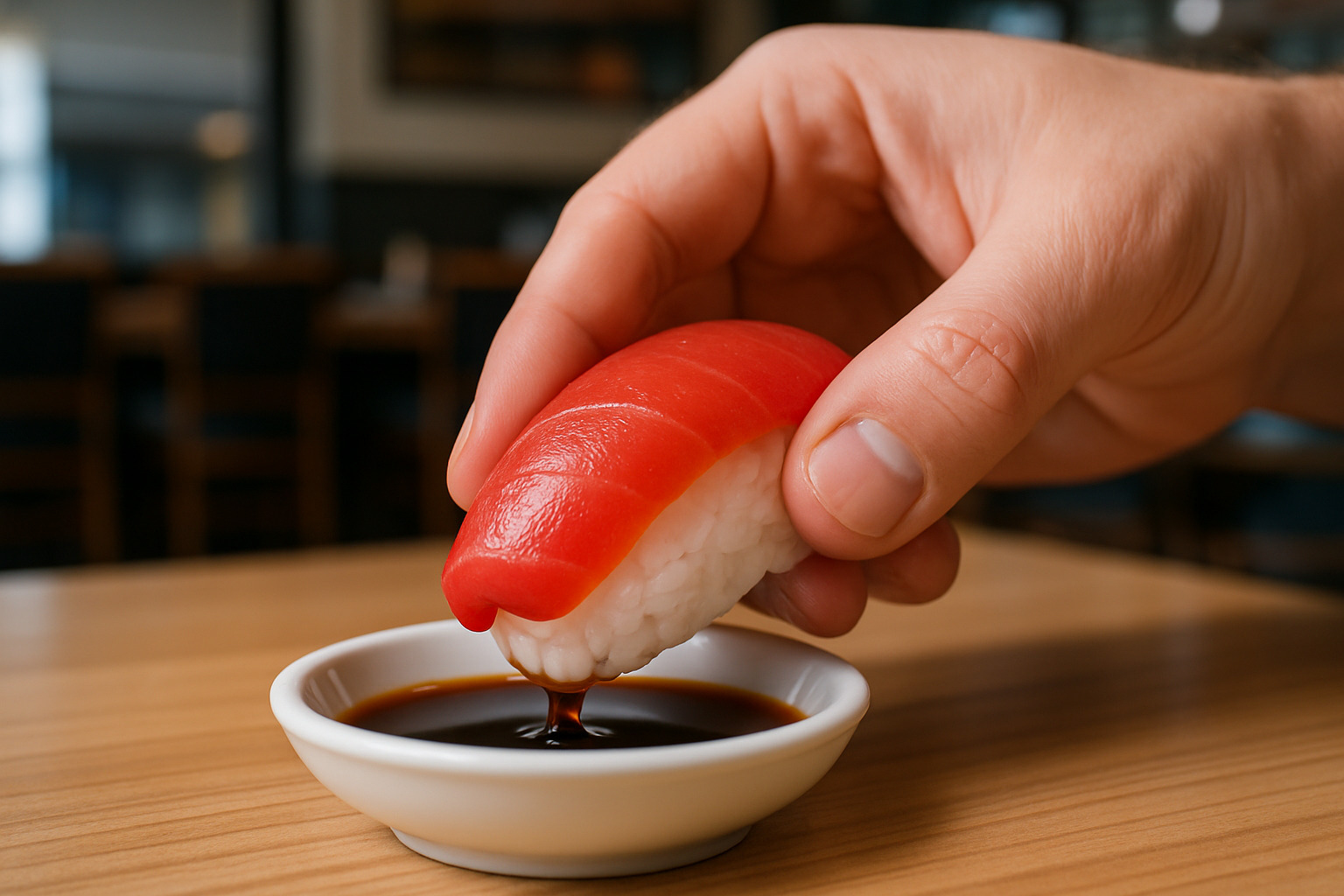
Now comes the fun part – eating your creation properly. Traditional nigiri etiquette isn’t about stuffy rules; it’s about maximizing your enjoyment while honoring the chef’s craft. Use your fingers, not chopsticks. The rice is specifically shaped to be finger food.
Turn each piece so the fish faces down, then lightly dip only the fish into soy sauce. The rice is already perfectly seasoned and will fall apart if it gets soaked in soy sauce.
The golden rule? One bite per piece. This isn’t about showing off – it’s about experiencing the intended flavor progression as the fish, rice, and wasabi meld together on your palate. Save the pickled ginger for between different types of nigiri – it cleanses your palate rather than competing with the sushi’s carefully balanced flavors.
Step-by-Step Home Nigiri Guide
Making nigiri at home becomes manageable when you have the right tools and understand the timing. Your essential toolkit includes a rice cooker or heavy-bottomed pot, a large bowl, a rice paddle, the sharpest knife you own, and a small bowl of vinegared water for keeping your hands damp.
The rice preparation process is where the magic happens. Use a 1:1.2 ratio of rice to water, and once it’s cooked, transfer it to your large bowl. Gradually fold in the sushi vinegar using a cutting motion – never stir in circles, which would make the rice mushy. Fan the rice while you work to achieve that characteristic glossy appearance.
Perfect sushi rice should feel slightly warm to the touch and have a subtle shine. Each grain stays distinct but cohesive, creating a texture that’s neither sticky nor dry.
Before you touch any fish, practice the hand-shaping motion with just rice. Cup your non-dominant hand and use your other hand’s fingers to gently press and shape small oval mounds. Think tiny football rather than rectangular brick.
Selecting Sushi-Grade Fish Safely
The safety of your homemade nigiri depends entirely on choosing the right fish and handling it properly. While “sushi-grade” isn’t an official FDA term, it typically means fish that’s been frozen to specific temperatures to eliminate parasites.
FDA guidelines require fish destined for raw consumption to be frozen at -4°F for seven days, or flash-frozen at -31°F for 15 hours. This process kills parasites like Anisakis, which can cause serious digestive problems.
Finding quality fish means building a relationship with a knowledgeable fishmonger who understands sushi preparation. Look for fish with bright, clear eyes, firm flesh that springs back when gently pressed, and a clean ocean smell.
Color tells a story too. Fresh fish should have vibrant, species-appropriate coloring. Salmon should be bright orange-pink, tuna should be deep red, and any fish with dull, grayish tones has likely seen better days.
Once you’ve brought your fish home, store it at temperatures below 40°F and plan to use it within 24-48 hours.
Scientific research on seafood safety
Popular Types and Modern Variations of Nigiri
The world of nigiri has blossomed beautifully from its humble Tokyo street-food beginnings. While purists still treasure the classics, today’s sushi scene offers an exciting mix of time-honored favorites and creative innovations.
Maguro (tuna), sake (salmon), and hamachi (yellowtail) consistently top popularity charts in American sushi restaurants. These approachable flavors provide the perfect entry point for newcomers while keeping seasoned sushi lovers coming back for more.
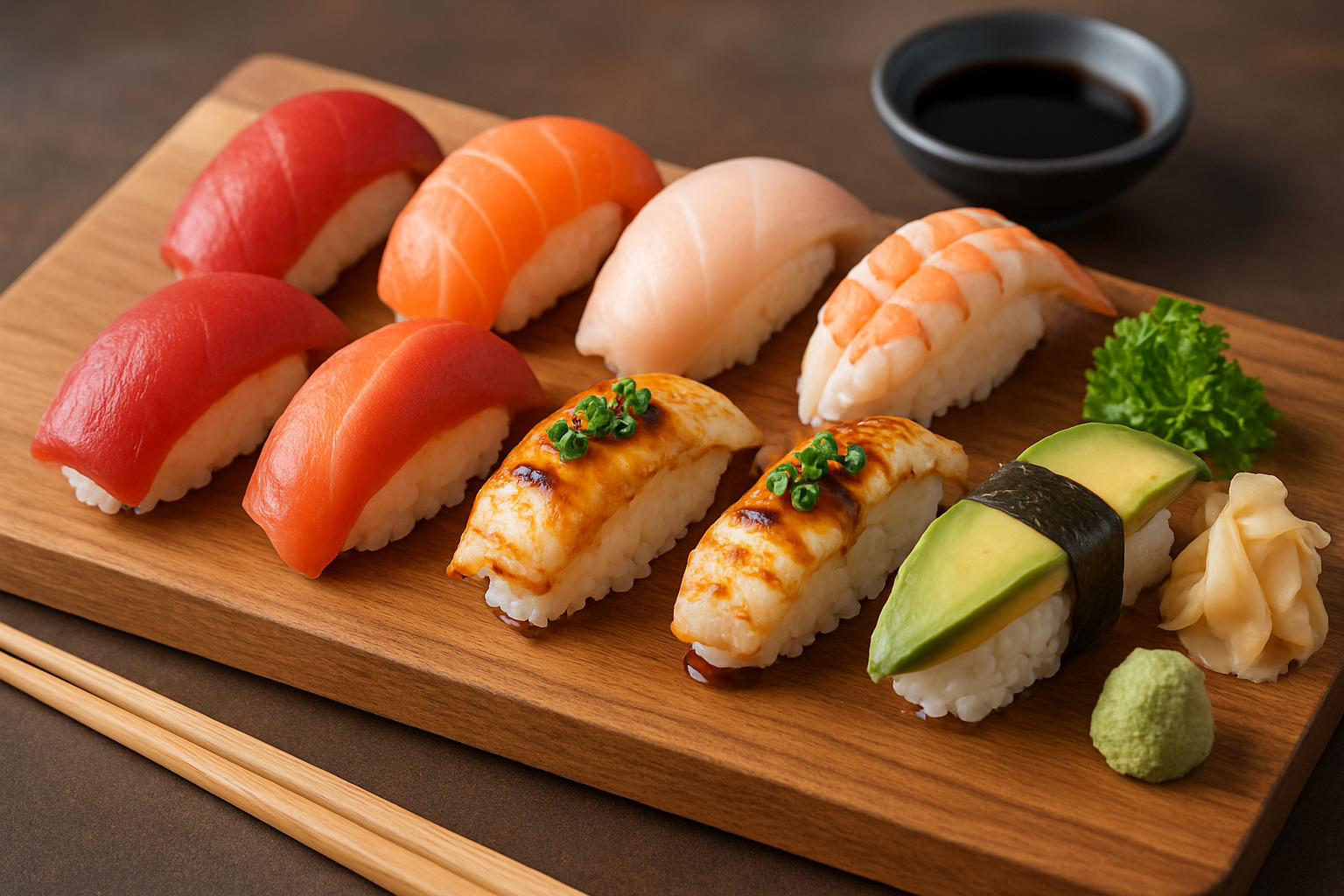
The modern nigiri scene accepts both tradition and innovation. Aburi (flame-seared) nigiri has taken New York City by storm, where chefs lightly torch the fish to create incredible textural contrasts. Meanwhile, vegetarian options have evolved far beyond simple avocado rolls, featuring marinated vegetables and plant-based proteins.
Traditional Stars: Tuna to Eel
Maguro (tuna) reigns supreme in the nigiri kingdom. The different cuts offer completely different experiences. Akami (lean tuna) delivers clean, meaty satisfaction with its deep red color and straightforward flavor. But otoro (fatty belly tuna) represents the ultimate indulgence – this pale pink treasure literally melts on your tongue, justifying its premium price tag that can reach $35 per piece at top establishments.
Sake (salmon) brings rich, buttery goodness that pairs perfectly with seasoned rice. Norwegian and Scottish varieties are particularly prized for their high fat content and clean taste.
Hamachi (yellowtail) strikes the perfect balance between richness and freshness. Its natural sweetness complements sushi rice beautifully, creating what many consider the ideal nigiri experience.
Unagi (freshwater eel) proves that cooked nigiri can be just as spectacular as raw varieties. Carefully grilled and glazed with sweet tare sauce, unagi offers complex flavors and incredibly tender texture.
Uni (sea urchin) challenges adventurous eaters with its unique custard-like texture and intense ocean flavor. Served as gunkan-maki style with nori wrapped around the rice, quality sea urchin delivers surprising sweetness that converts many initial skeptics.
Beyond Seafood: Vegetarian & Beef Nigiri
Nigiri doesn’t have to swim to be spectacular. Tamago (sweet egg omelet) has graced sushi counters for centuries, offering mild flavors and custard-like texture that appeals to diners of all ages.
Modern vegetarian nigiri has evolved into an art form of its own. Creamy avocado provides buttery richness that mimics fatty fish, while marinated eggplant offers complex umami flavors that satisfy even dedicated carnivores.
Perhaps the most surprising modern innovation is beef nigiri. Using premium cuts like Denver steak, creative chefs craft meat-based nigiri with Korean-inspired glazes featuring gochujang, lime, and soy sauce.
Fusion & Western Twists
Aburi nigiri represents one of the most successful modern innovations to emerge from creative sushi kitchens. Lightly torching the fish surface creates incredible textural contrast while developing new flavors through caramelization. Salmon aburi has become particularly beloved in North American restaurants.
Contemporary fusion elements like truffle oil, microgreens, and specialty sauces have found their way onto nigiri menus worldwide. While traditional sushi masters might disapprove, these creative additions attract new audiences to nigiri.
Sustainability consciousness has also shaped modern nigiri evolution. Forward-thinking chefs increasingly showcase lesser-known sustainable species, educating diners about ocean conservation while expanding their culinary horizons.
Common Myths & Misconceptions About Nigiri
Let’s clear up some confusion that keeps people from fully enjoying nigiri. These widespread myths can make this beautiful dish seem more intimidating than it actually is.
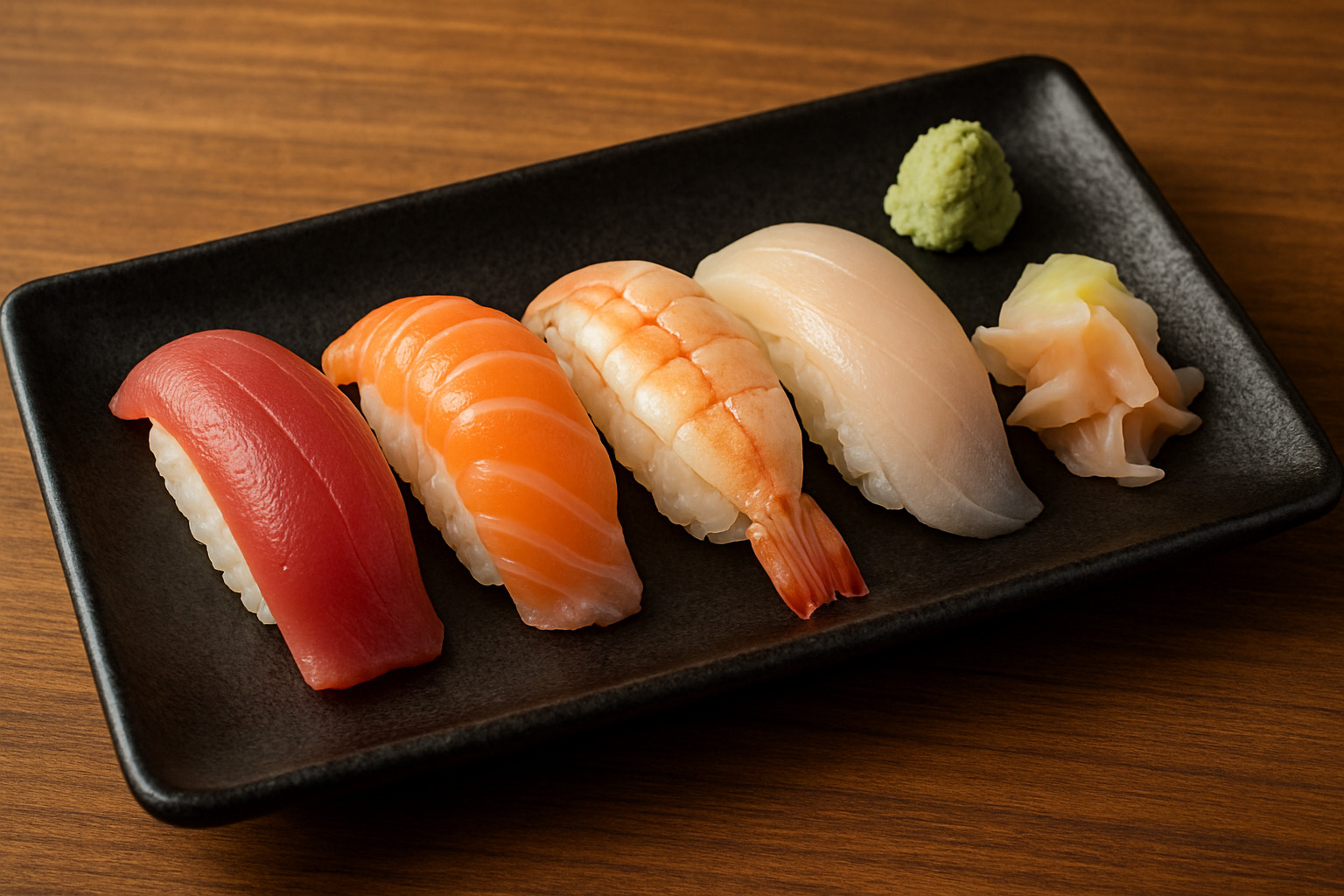
The biggest misconception? That all sushi means raw fish. This simply isn’t true. The word “sushi” actually refers to the seasoned rice, not what sits on top of it. Plenty of nigiri varieties feature cooked ingredients that taste absolutely delicious.
Think about shrimp nigiri – those plump, sweet shrimp are always cooked. Unagi (grilled eel) gets brushed with a glossy, slightly sweet sauce that caramelizes beautifully. And tamago, the golden egg omelet that’s almost like a savory custard, never sees a raw moment.
Here’s a mistake that makes sushi chefs cringe: dipping the rice side into soy sauce. When you do this, the carefully seasoned rice absorbs too much liquid and falls apart in your hands. The rice is already perfectly seasoned – it doesn’t need more salt. Always flip your nigiri so the fish touches the soy sauce first.
Another myth that surprises people: you don’t need chopsticks for nigiri. In fact, traditional etiquette says to use your fingers! The rice is shaped specifically to be picked up easily, and chopsticks can actually squeeze the delicate structure too hard.
Many people worry that nigiri isn’t healthy, but this couldn’t be further from the truth. A typical piece contains only about 70-80 calories and delivers high-quality protein plus those beneficial omega-3 fatty acids. The fish provides vitamin D, selenium, and other nutrients that are hard to get elsewhere.
The final myth worth busting: that sustainability doesn’t matter in sushi culture. Modern sushi restaurants increasingly focus on responsible sourcing, featuring seasonal catches and working with suppliers who follow sustainable fishing practices.
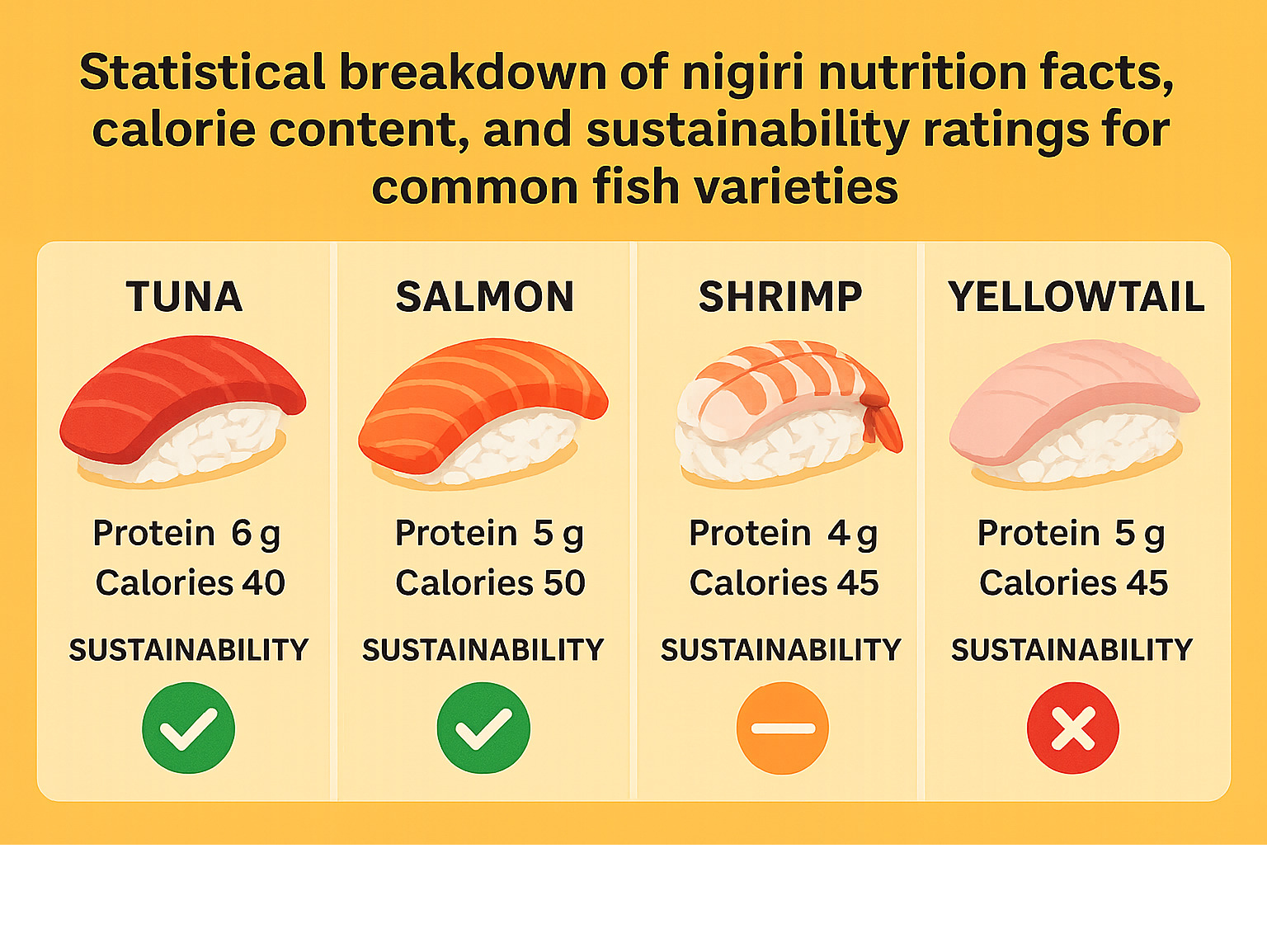
Understanding these facts helps you approach nigiri with confidence. There’s no need to feel intimidated by rules that don’t actually exist or worry about health concerns that aren’t based in reality.
Frequently Asked Questions About Nigiri
When you’re diving into nigiri, questions naturally arise. Whether you’re planning your first sushi trip or perfecting your technique at home, these common questions will help you steer this beautiful culinary art with confidence.
How do you pronounce “nigiri” correctly?
Nigiri is pronounced “nee-gee-ree” with three clear syllables that flow together naturally.
Break it down like this: “nee” sounds like the word “knee,” “gi” uses a hard “g” sound like in “give,” and “ri” rhymes with “free.” Many people mistakenly say “nigh-jee-ree,” but the correct Japanese pronunciation keeps all three syllables short and crisp.
The word itself tells a story – it literally means “two fingers” in Japanese, referring both to the traditional portion size and the hand-shaping technique that master sushi chefs use.
Can nigiri be vegetarian or cooked?
Nigiri is so much more diverse than many people realize! You absolutely don’t need raw fish to enjoy authentic nigiri experiences.
Traditional cooked options have been around for centuries. Tamago (sweet egg omelet) offers a custard-like texture that’s perfect for beginners. Unagi (grilled eel) brings rich, complex flavors with a glossy sweet glaze, while ebi (cooked shrimp) provides familiar tastes in traditional nigiri form.
Vegetarian varieties are flourishing in modern sushi culture. Avocado nigiri delivers creamy richness that pairs beautifully with seasoned rice. Marinated vegetables, seasoned mushrooms, and inari (sweet seasoned tofu pockets) create satisfying plant-based options.
What is the healthiest nigiri choice?
Salmon nigiri consistently ranks as the healthiest option. Each piece delivers impressive nutritional benefits – high-quality protein, heart-healthy omega-3 fatty acids, and essential vitamins wrapped in a perfectly portioned package.
A typical salmon nigiri piece contains about 80 calories and provides roughly 31% of your daily vitamin D needs per 100 grams. Those omega-3s support both heart and brain health.
Tuna varieties offer excellent lean protein with minimal fat content. If you’re watching calories closely, akami (lean tuna) gives you maximum protein with fewer calories than fattier cuts.
Conclusion
Nigiri represents something truly special in the culinary world – it’s where ancient Japanese tradition meets modern creativity in perfect bite-sized harmony. From Hanaya Yohei’s street stall in 1820s Tokyo to today’s innovative fusion creations, this deceptively simple dish continues to capture hearts and palates worldwide.
What makes nigiri so remarkable isn’t just its taste, but the story it tells with every piece. Each nigiri carries centuries of craftsmanship, from the precise rice preparation to the delicate hand-pressing technique that gives the dish its name. Yet despite requiring years to master, nigiri remains wonderfully approachable for anyone curious enough to try.
For food lovers and adventurous eaters, nigiri opens doors to understanding Japanese culinary philosophy. It’s about finding perfection through simplicity, celebrating the natural flavors of seasonal ingredients, and respecting the skill that transforms basic components into something extraordinary.
The beauty of nigiri lies in its honesty – there’s nowhere to hide imperfections when you’re working with just rice, fish, and a touch of wasabi. This transparency demands excellence from every element, creating those magical moments when everything comes together in a single, perfect bite.
Whether you’re planning to explore authentic sushi experiences in New York City or ready to try making nigiri at home, each piece represents a small act of culinary artistry. The journey from curious beginner to confident nigiri appreciator is part of what makes food exploration so rewarding.
As you continue finding global flavors and culinary traditions, let nigiri remind you that sometimes the most profound experiences come in the simplest packages.

